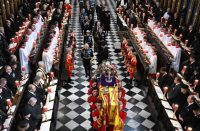Hugh Wetmore is a songwriter and student of worship trends. He invites you to join the worship conversation by commenting on his monthly column.
With a passionate longing to hear congregations sing with enthusiasm, we identified two factors last month that identify “super singable songs”:
- Enthusiasm for the message of the song.
- Songs can be sung spontaneously — just one person can trigger a song. Even without instruments.
Now add to these: rhythm and don’t crush the words
Rhythm
Everyone values rhythm — play a good song and even 3-year-old children will move to its rhythm. Watch any music program on TV, and the musicians in the studio will tap their feet, move their arms, and jerk their heads — enjoying the rhythm.
To get the congregation of non-professionals singing, avoid complicated rhythms. Choose songs with an easy beat. KISS = “Keep it Simple, Stupid!” The simpler the rhythm, the easier it is to sing with relaxed enthusiasm.
Notice how some songs begin with an accented beat, and others begin with an unaccented beat … or even a few unaccented beats. Pundits have given these rhythms technical names:
Trochaic: long short – ^ – ^
as in ‘JEsus LOver OF my SOUL’
Iambic: short long ^ – ^ –
as in ‘The LORD’S my SHEPherd’
Dactyllic: long short short – ^ ^ – ^ ^
as in ‘my LIFE is in YOU, Lord, my STRENGTH …’
Anapaestic: short short long ^ ^ – ^ ^ –
as in ‘Let us BREAK bread toGEther, we are ONE. ‘
Songs that are consistent in their chosen rhythm accents are more singable than songs that mix the rhythm accents.
Ideally, the spoken rhythm of accented and unaccented beats should match the musical rhythm of accented and unaccented beats. If these accents match well, the singing will flow easily. Try not to choose songs where there is a serious mismatch between spoken words and their musical rhythm. (A skilled wordsmith can rewrite the words to fit.)
If this is too technical for you, don’t give up. Feel the rhythm — if it feels steadily consistent, and fits the words, go for it. If it doesn’t, forget it.
Don’t crush at the turnstiles
The recent tragedy at the FNB Stadium happened because too many people tried to get through too small a space too quickly. If we squash too many words or syllables into too small a musical space, our singing will be disastrous too.
Ideally, one note is a turnstile just big enough for one syllable. Sometimes a song will give plenty of elbow room when it provides multiple notes for one syllable — as does the swaying song Amen. But avoid songs that squeeze multiple syllables, or words, into one note.
Have you noticed that most congregations seldom manage to sing all the words in the opening line of Christiansen’s May we be a shining light to the nations? That’s 11 syllables crushed into the space of only nine actual notes. (He tries to wriggle out of his crushing dilemma by using semi-quavers instead of quavers.) But when we come to sing the last stanza, every word fits snugly into those same notes: “May Your Kingdom come to the nations …” Now suddenly we are fitting nine syllables into nine notes — and it goes so much better. Amend this song by dropping the “May we” words, and start the verses with “Be a …”. Then the singing will zing!
Similarly, Paul Oakley’s 1995 beautiful song, Jesus, Lover of my soul, tries to squash too many words through the turnstiles of the congregation’s lips (‘as if You should do things my way’). I’ve not yet heard it sung smoothly from beginning to end. I’ve listened to it again on and realised afresh how the inconsistent slow-fast rhythm makes it difficult for congregational singing. Leave such songs to platform performers.
I close with an example of a song that meets all the above criteria:
10 000 Reasons has been called the best worship song ever. Maybe that’s over the top, but your congregation will easily sing it with enthusiasm!
Be encouraged as you get your congregation singing!








Thanks for this excellent article. I have always problems jamming too many words into too few notes!